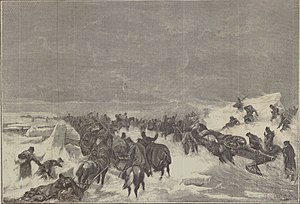This article may require cleanup to meet Wikipedia's quality standards. The specific problem is: Vaguely moved out of AFC, needs MOS arrangement, and styling. (July 2024) |
The crossing the Gulf of Bothnia, specifically Kvarken (Swedish: korsar Bottenviken; Russian: Переход через Кваркен), was a march of Russians through Kvarken, Gulf of Bothnia, to the territory of Sweden at Umeå. It was during the Finnish War in March 1809.[7]
| Crossing Kvarken | |||||||||
|---|---|---|---|---|---|---|---|---|---|
| Part of the Finnish War | |||||||||
 Crossing Kvarken | |||||||||
| |||||||||
| Belligerents | |||||||||
|
|
| ||||||||
| Commanders and leaders | |||||||||
|
|
| ||||||||
| Strength | |||||||||
| 1,000[a] | 3,000[4] | ||||||||
| Casualties and losses | |||||||||
| 400 captured[5] | ~200[b] | ||||||||
Background
editFor the whole winter, the operation was in preparation. In the middle of February 1809 followed the appointment of Lieutenant General Michael Andreas Barclay de Tolly as commander of the Vasa Corps, who pushed forward preparations for the campaign. On March 6 an order was read at the assembly point, in which Barclay, without concealing the labours to come, expressed his confidence that "for Russian soldiers the impossible does not exist."[6]
Hike
editThe march began on March 8, 1809, and, according to its idea, was a unique event in world history. In the cold more than -15 degrees, Russians were walking across the icy desert towards Umeå. In front of the Swedish coast, they burned two merchant ships to keep warm. The troops had to abandon their artillery halfway due to the inability to quickly transfer it across the ice.[2] They were opposed by a detachment in Umeå numbering no more than 1,000 people. Seeing the numerical superiority of the Russians, the Swedes tried to let go, but their rearguard units were overtaken and defeated, for example, a column under the command of Pavel Filisov engaged 3 companies of Swedes and forced them to retreat, taking 36 prisoners including 1 officer.[6] On March 10, Barclay de Tolly entered Umeå. The Swedish troops there surrendered and promised to surrender all Västerbotten.[3]
Memory
editAlexander I personally presented individual unique awards to each participant of the campaign.[8]
References
edit- ^ Barclay 1933, p. 298.
- ^ a b Egorshina & Petrova 2023, p. 192.
- ^ a b Nive 1910, p. 333.
- ^ Shkvarov 2012, p. 506.
- ^ Shkvarov 2012, p. 507.
- ^ a b c Velichko et al. 1913.
- ^ 1911 Encyclopædia Britannica/Barclay de Tolly, Michael Andreas
- ^ Медаль За переход на шведский берег. Сайт «Награды императорской России 1702—1917 гг.».
Notes
editSources
edit- Shkvarov, Alexei (2012). Россия и Швеция. История военных конфликтов 1142-1809 [Russia and Sweden. The history of military conflicts 1142-1809] (in Russian). Saint-Petersburg: RME Group Oy:Алетейя. ISBN 978-5-91419-754-1.
- Nive, Pyotr (1910). Русско-шведская война 1808—09 г.г. (in Russian). St. Petersburg: Военная Типография.
- Egorshina, O.; Petrova, A. (2023). История русской армии [The history of the Russian Army] (in Russian). Moscow: Edition of the Russian Imperial Library. ISBN 978-5-699-42397-2.
- Velichko, Konstantin; Novitsky, Vasily; Schwartz, Alexey von; Apushkin, Vladimir; Schoultz, Gustav von (1913). "КВАРКЕНЪ" [Kvarken]. Sytin Military Encyclopedia (in Russian). Vol. 12: Кальяри – Коалиционные войны. Типография Т-ва И. Д. Сытина. pp. 477–479. Retrieved 27 June 2023.
- Barclay, Charles (1933). A history of the Barclay family, with full pedigrees from 1066 to 1933.